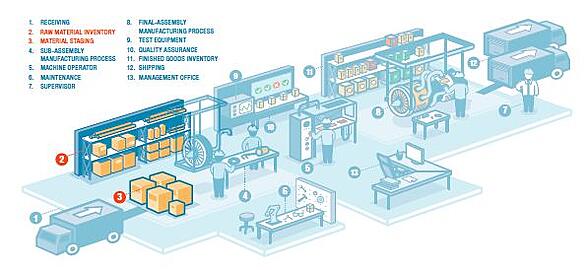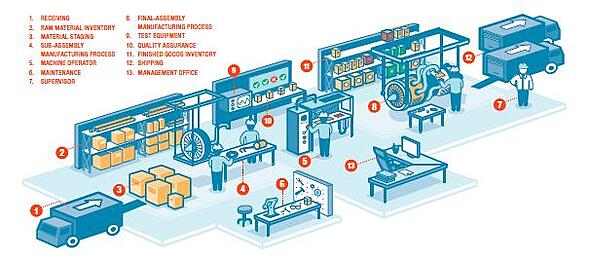Ten million dollars. That’s a lot of cash. And for companies in the complex discrete manufacturing industry, the amount of inventory tied up in Work-In-Progress (WIP) can equal or even exceed this amount depending on the number of plants in operation.
It’s not difficult to see why this is an important initiative for complex discrete manufacturers, or why small improvements in processes and WIP visibility can quickly translate to significant benefits and cost reductions at a greater scale, freeing up large amounts of working capital.
But achieving WIP improvement is not as simple as it may seem, and is a goal that has proven somewhat elusive for many complex discrete manufacturers. While there are narrow, and even intuitive approaches to WIP being applied today, they often fail to meet the target WIP improvements that complex discrete companies are striving for.
In this post, we’ll discuss why a narrow approach to improving WIP is often best taken as a starting point rather than an end-all, and why a more comprehensive strategy often drives better results.
The Importance of WIP in Complex Discrete Manufacturing
If the initial figure at the beginning of this post didn't convince you, research shows just how focused complex discrete manufacturers are on improving WIP. According to our most recent Manufacturing Operations Management (MOM) survey, 100% of complex discrete respondents had some type of operational excellence program in place (tweet this data), and 75% of these contained WIP-focused initiatives like Lean Manufacturing or Six Sigma (tweet this data).
Additionally, 80% of complex discrete manufacturers responded that they measure WIP (tweet this data) and know their company’s current performance—and want to improve. Wanting to improve probably comes with little surprise, but what might raise an eyebrow or two is by just how much—the average goal of WIP improvement is a lofty 33% (tweet this data). It's clear: WIP is a top-of-mind issue for many complex discrete manufacturers, and that these companies are nowhere near where they need to be.
Why a Narrow Approach to WIP Improvement Is Suboptimal
There are technology solutions available today focused specifically on WIP management improvement, like Inventory Management and Optimization. While these can be useful tools, they typically focus only on WIP flow. Unfortunately, WIP flow only impacts a few stages of the production process and does little to better enable the workforce to address issues that impact inventory as production is occurring.
This approach doesn’t help the plant handle the dynamics of issues that may arise from maintenance issues, supplier deliveries, customer orders, quality variations, or production anomalies. The figure below shows a full range of shop-floor activities, and you can see the limited portion on which these solutions really have focus.

Complex discrete manufacturers that have adopted WIP Inventory Management/Optimization software have seen small increases in average WIP inventory turns per year—4.5 for those that have implemented versus 4.4 for those who haven’t. Hardly the one-third improvement on these companies' wish lists.
While these applications serve important functions, we'll see next why they are often best approached as a foundation for building a more comprehensive WIP solution.
Approaching WIP Reduction with Comprehensive MES/MOM
Before diving into a comprehensive approach to WIP management, let's take a step back and mention the variances in how different manufacturing companies define the manufacturing operations technology application space. There are several companies that define Manufacturing Execution Systems (MES) simply as a Production Execution application or, even more narrowly, as a way to measure Overall Equipment Effectiveness (OEE) across several plants.
There are others that take a more encompassing view of MES, approaching what LNS Research sees as the evolution to a Manufacturing Operations Management (MOM) scope that connects shop-floor automation systems to the overall enterprise software and includes applications such as Quality Management, Planning, Scheduling & Dispacthing, and Production Execution applications.
Preferred terminology aside, it's this latter, comprehensive approach to operations that's driving value in the WIP arena, as these applications touch the full range of shop-floor activites--both those that have direct and indirect impact on WIP--as shown in the figure below.

For example, companies that have implemented comprehensive MES software functionality that covers the above operations are reporting a 49% higher takt time than those who have not (tweet this data). Additionally, survey respondents that had this software in place experienced an average of 5.2 inventory turns per year versus 3.5 for those that did not (tweet this data). A much larger improvement than found in the narrow approach to WIP.
Maximize Your WIP Management Efforts
The research shows that taking a broader view of WIP management pays off in the end, and the ROI on the initial investment can be easily justified in complex discrete industries when the potential savings, compounded with each working plant beholden to inefficient processes and a lack of visibility, are considered.
To learn more on how to improve WIP in complex discrete manufacturing, including other software strategies and process optimization, click below for a free download of our eBook "A Guide to Leveraging MES to Optimize WIP."